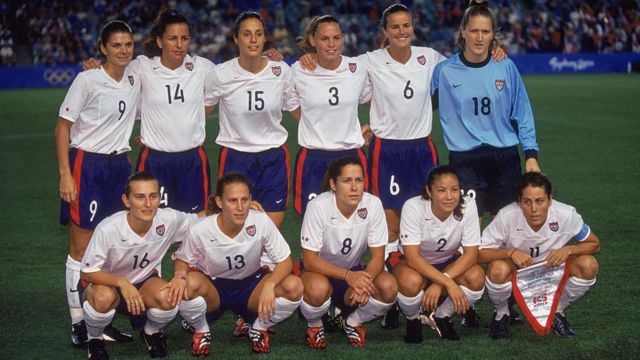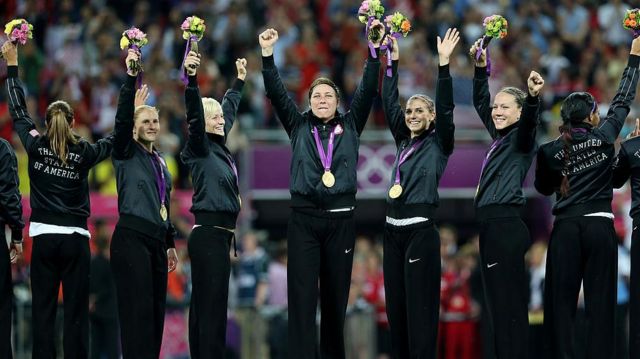Which explains why soccer is one of the most popular sports among women in the US
In the world's most popular sport, the United States occupies a curious position.
While the country's men's soccer has never made it to the top and can't even generate as much excitement as sports like American football, baseball or basketball, its women's team is a powerhouse that has dominated the world rankings for decades.
If in most countries football is still considered by many to be a masculine stronghold, in the United States it is different.
Football has always been seen more as a women's sport and is one of the most popular among women in the country, alongside athletics, volleyball and basketball.
She emphasizes that, in the United States, it is sports like American football that represent this masculinity. "That left an opening for women to play football because it was considered less masculine," she points out.
But the popularity of women's football in the country, and the dominance of its national team on the world stage, did not happen by chance, and are the result of a series of historical, cultural and political factors, among them the fight for gender equality.
João Fellet tries to understand how Brazilians reached the current degree of division.
episodes
End of Podcast
In the early 1970s, when countries like Brazil still prohibited the practice of women's soccer, the United States adopted a federal law that became known as Title IX (Title IX). That law, signed into law by then-President Richard Nixon in 1972, prohibited "sex discrimination" in education.
The original focus was not specifically on sport, and the law encompassed any education program or activity that received federal funding. The aim was to prevent girls and women from suffering discrimination in educational institutions and to ensure that they had equal opportunities.
But soon the impact began to be felt in sports and, specifically, in women's football. To comply with the law, schools and universities were obliged to reduce the discrepancies prevailing at the time and to ensure that girls and women had the same type of access to sports offered to male students.
In this context, football emerged as a way to adapt to changes. The large number of athletes on the teams, with 11 players, in addition to the reserves, facilitated the inclusion of more girls and women.
In addition, the practice only required a field, a ball and goals, which represented a low-cost option for educational institutions.
"For athletic directors, it made a lot of sense, both in terms of numbers and resources," says Narcotta-Welp, who for ten years served as a football coach on teams from different American universities.
The USA team is qualified for the round of 16 of the World Cup
Growth
The law was initially met with resistance from educational institutions and the National Collegiate Athletic Association (NCAA), responsible for sports programs at universities across the country.
However, in the following years the schools ended up having to accept and began to adapt, and from the 1980s the results began to become more visible.
The encouragement and opportunities for girls and women to practice soccer led to an explosion in the number of students dedicated to the sport in schools, universities and clubs across the country.
In 1971, the year before the law took effect, only 700 female high school students in the United States played soccer, according to data from the National Federation of State High School Associations.
Twenty years later, in 1991, when the first women's football World Cup was held, that number had jumped to over 121,000. Last year, there were 375,000.
At the collegiate level, the 1971-1972 season had just 313 players, according to NCAA data. Ten years later, there were 1,855 female athletes on 80 teams. Currently, there are 28,000 players in over a thousand teams.
In the case of universities, an important advance since the implementation of the law was also the equivalent number of scholarships offered to athletes of both sexes, which opened the way for many women to be able to use their talent in sports and, specifically, in football. , to gain access to higher education.
"The opportunity to play college football and earn a scholarship was also a push for women's soccer, not to mention the success of the US women's team on the field," says Narcotta-Welp.
Today, more than 50 years after it came into force, the law has benefited generations of athletes and is considered an example of success in the development of women's sports. The investment in this sport has generated a huge bank of talent, from which the best end up in the US team.
Fans of the USA women's national soccer team during the 2023 World Cup
Prohibition
But America's leadership in women's soccer is not the result of the law alone. Narcotta-Welp notes that while the law only affected educational institutions, football was at the same time conquering other venues, such as clubs and community spaces.
"Fathers and mothers viewed soccer as a non-violent sport, unlike American football," says Narcotta-Welp.
"There was an increase in the number of girls playing soccer because it was considered a more egalitarian sport that everyone could play."
Other factors also contributed to American dominance, including decades of neglect or even banning of the sport in other countries, on the grounds that it would be harmful to women's health or fertility.
In Brazil, women were banned from playing football for almost four decades, due to a law that was in force from 1941 to 1979. Women's football was only regulated in the country in 1983.
In England, women's football games were banned for half a century, starting in 1921. Germany banned professional women's football from 1955 to 1970.
Thus, while in the United States girls had the opportunity to play and received training from a young age, bans in these and several other countries resulted in a lack of incentives and investments in women's soccer.
wins
The United States national team was formed in the mid-1980s, and when the first women's soccer World Cup was held in 1991 in China, the American team was the champion, beating Norway.
This victory, despite being celebrated by the most attentive fans, did not generate much attention in the United States.
Five years later, the 1996 Olympic Games, held in Atlanta, were the first to include women's soccer, and the US team won the gold medal, beating China.
The winning team featured players like Mia Hamm, who for years was the portrait of women's football in the country.
But it was only at the 1999 World Cup, held in the United States, that the American team consolidated its popularity with the public.
In the final match, the team beat China on penalties, in front of a packed stadium of 90,000 people and more than 40 million TV viewers.
According to Narcotta-Welp, if for those who already followed football closely the turning point occurred with the victory in the 1991 cup, for the lay public the milestone was 1999.
In addition to Mia Hamm, the 1999 national team made other players such as Brandi Chastain and Michelle Akers into stars.
Many attracted publicity and sponsorship from famous brands, such as Nike, and became idolized by girls across the country, who dreamed of a career in soccer.
The USA team before the women's soccer final at the Olympics in Sydney, Australia, on September 28, 2000. Norway won 3-2
In the following years, the American team won two more world cups, in 2015 and 2019.
The result is even more impressive when you consider that the current women's cup is only the ninth to be held. The United States has won half of the previous eight championships.
The country's women's football also took gold in three other Olympics (2004, 2008 and 2012), in addition to several victories in different championships.
The leadership of the US team as number one in the world, at the top of the Fifa ranking, contrasts with the performance of the men's soccer team, which occupies the 11th position and has never won a World Cup.
But even with this superiority, women spent years being paid far less than male players and facing other inequalities in everything from the quality of travel accommodations to general playing conditions.
It wasn't until 2022 that the players achieved equal pay, after suing the United States Soccer Federation and winning an unprecedented settlement worth $24 million.
According to Narcotta-Welp, despite the positive result, the impact of this victory for players who are not at the top is still uncertain. "I'm sure some inequalities will remain," she says.
USA team with the gold medal at the 2012 London Olympics
Future
The trajectory of more than three decades of success in women's soccer in the United States has impacted the sport around the world. Players from several countries seek to train and play in American universities and clubs.
An analysis by the newspaper USA Today calculates that, among the 32 teams participating in the current World Cup, 27 have players with some kind of connection with the United States. The newspaper mentions among them the Brazilian Marta, who plays for Orlando Pride, in Florida, and has played for other clubs in the country.
Recently, other countries have been making up for lost time, with greater interest and investment in the sport, which may pose challenges for the United States. In the most recent FIFA ranking, the country is followed by Germany, Sweden, England and France. The Brazilian team appears in eighth place.
Narcotta-Welp points out that, while in the United States, college football remains the natural destination for athletes who start playing the sport in school, countries like Germany or France are identifying talent earlier and putting these players directly into professional leagues.
"I think there is currently an attempt to make that transition (in the United States)," he says.
"I think we're going to start to see more and more female players skipping university to play (directly) in the professional league," she bets.
The teacher believes that the current moment is of "a new world order" in women's football. She predicts that the US team should remain among the world's top teams, but cautions that other teams are getting better.
"Each match will be more difficult to win," he says.







No comments:
Post a Comment